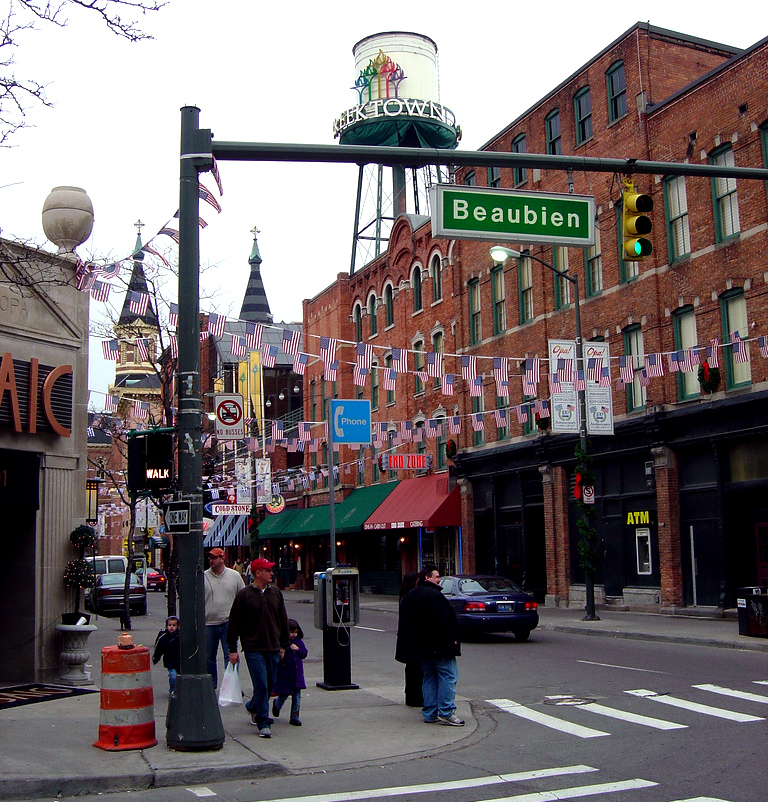- Greektown (Detroit, Michigan)
Infobox_nrhp | name =Greektown Historic District
nrhp_type = hd

caption = Monroe Avenue
location=Detroit, Michigan
lat_degrees = 42
lat_minutes = 20
lat_seconds = 6
lat_direction = N
long_degrees = 83
long_minutes = 2
long_seconds = 32
long_direction = W
locmapin = Michigan
area =
architect= Multiple
architecture= Late Victorian, Renaissance, Romanesque
added =May 06 ,1982
governing_body = Private
refnum=82002902cite web|url=http://www.nr.nps.gov/|title=National Register Information System|date=2008-04-15|work=National Register of Historic Places|publisher=National Park Service]Greektown is an historic neighborhood in
Detroit ,Michigan , located just northeast of the heart of downtown, along Monroe Avenue between Brush and St. Antoine Streets. It is a primarily commercial district, dominated by Greek-themed restaurants, but also includes the Second Baptist Church and theGreektown Casino within its boundaries.History
The area known today as Greektown was first settled in the 1830s by German immigrants, who created a primarily residential neighborhood in the area. [http://www.nps.gov/history/nR/travel/detroit/d12.htm Greektown Historic District] from the National Park Service] However, in the earliest years of the 20th century, most of the German residents began moving from the neighborhood into areas further from downtown. As the Germans left the area, fresh Greek immigrants moved in, spurred by Theodore Gerasimos, the first documented Greek immigrant in Detroit. The newly-arrived Greeks established businesses in the neighborhood.
However, by the 1920s, the area was becoming primarily commercial rather than residential, and the Greek residents began moving out; however, the restaurants, stores, and coffeehouses they established remained. The next thirty years brought a menage of immigrants to the few residential spaces left in the neighborhood. Redevelopment in the 1960s led to a shrinkage of the neighborhood as buildings were razed to provide space for municipal buildings and parking. By 1965, the neighborhood had been reduced to little more than a single block of commercial buildings.
Realizing the culturally significant neighborhood was in danger of being snuffed out, Detroit's Greek leaders banded together. With the help of the Mayor's office, the streetscape and building exteriors were improved, and additional street lighting was installed. [http://www.greektowncasino.com/Dining/Greektown/ Greektown history] from Greektown casino] The neighborhood threw a Greek festival in 1966, timed to coincide with Fourth of July celebrations. The festival was a success, and was continued for years until turnout grew too large. By that time, Greektown was firmly established in Detroit. The Greektown Historic District was listed on the
National Register of Historic Places in 1982.Greektown today
Greektown today remains distinctly Greek. The neighborhood is a popular restaurant and entertainment district, having many restaurants that serve authentic Greek cuisine, as well as one of the city's three casinos,
Greektown Casino . Certain buildings on Monroe Street are themed to resemble theParthenon ,Pegasus , and other forms of Greek architecture.Greek music is also played on Monroe Street throughout the day. Well known restaurants include The Laikon Cafe, Cyprus Taverna, Pegasus Taverna, and Pizza Papalis. TheDetroit People Mover has a station at the Greektown Casino on Beaubien Street between Monroe Street and Lafayette Boulevard.References
External links
* [http://www.visitgreektown.com/index.html Greektown Merchant's Association]
* [http://www.greektowncasino.com/ Greektown casino]
Wikimedia Foundation. 2010.
